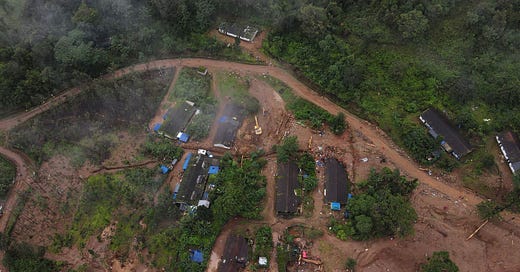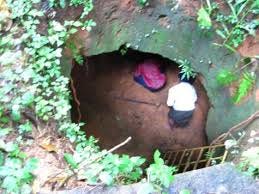Anatomy of a landslide
Landslides have left behind a trail of destruction in Wayanad - but what happened?
In the past week, images of the idyllic, green hills of Wayanad, marred by muddy floodwater became the centre of news, after a devastating landslide left behind a trail of destruction in Kerala’s Meppadi, Mundakkai, and Chooralmala, claiming hundreds of lives.
The devastation is such that rescue and relief operations are still ongoing a week in, with the count of bodies recovered from the landslides-hit areas continuously mounting, and hundreds still missing underneath the debris.
Here is the drone footage capturing the devastation in Kerala:
However, even with their wide-ranging impact, landslides are not considered to be as destructive as flash floods, droughts or storms. They are also less studied as they are localised phenomenon.
🤔 So what causes a landslide?
Landslides usually occur in mountainous regions with sharp slopes, after large amounts of boulders, loose mud, soil, rock and debris roll down slopes and hillsides, and while descending at a great momentum, trample over and carry vegetation and buildings along its path.
Largely, two factors cause this displacement of land:
📌 Conditioning factors: These are related to the soil topography, rocks, geomorphology, and slope angles, among other factors. These factors make some parts of the country more vulnerable to landslides than other parts.
📌 Triggering factors: Some factors act as propellers, these are intense rainfall, and anthropological activities such as thoughtless changes of land use, road and bridge building, haphazard and unscientific construction, and large-scale destruction of forests.
⛰️ So, what happened in Kerala?
Experts have indicated that deforestation for the creation plantations, quarrying, and heavy rainfall in the region led to the disaster on July 30.
S Abhilash, director of the Advanced Centre for Atmospheric Radar Research (ACARR) at Cochin University of Science and Technology, said:
“Most of the landslides that are taking place in Kerala are around plantation areas, indicating another major triggering factor — agricultural activities such as monocropping, in which large, native trees, which hold the top soil to the bedrock, are cut down. These trees are being replaced by big plantation crops, such as tea and coffee, which have shallow roots.”
Additionally, 4 years ago, a landslide in Puthumala, Kerala led to ‘soil piping’ — the erosion of subsurface soil, leading to the creation of large air-filled voids, like tunnels, underneath the surface.
A Down to Earth report notes that Puthumala is just two kilometres from where the July 30 landslides occurred.
The report also states that M G Manoj, a scientist from the Advanced Centre for Atmospheric Radar Research, has stated that the recent landslides exhibit all characteristics of the causative factor being soil piping.
The soil’s inability to absorb large amounts of water in a short period and the significant underground tunnels formed by the Puthumala tragedy, must have contributed to the scale of the disaster, he indicated, as per the report.
After the Wayanad landslide, the Indian Space Research Organisation (ISRO) revealed satellite images of the disaster, showing the severe damage in Chooralmala town in Kerala, and the flow of the debris that caused it.
Is the frequency of landslides increasing?
Yes. Scientific consensus is that the effects of climate change, such as extreme weather events, are increasing the frequency of these disasters. However, only climate volatility is not the reason for the increase in peril.
These phenomenon are also a direct result of human interventions in form of deforestation, massive growth in traffic, unsustainable rise in permanent settlements, and a significant rise in buildings.
In fact, as per reports, India recorded 3,285 landslides between 2015 and 2022, with a significant increase in frequency over this period. The Geological Survey of India also indicates that about 12.6 per cent of India’s land area, excluding snow-covered regions, is prone to landslides.
We, at Indian Express, have been covering the Wayanad disaster extensively. To read our latest report from Kerala, click here.
That’s all for today.
Catch you next time,
Ayesha
You can write to me with comments, feedback or suggestions at ayesha.jain@indianexpress.com.






